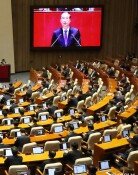Citizens Suffer from Snowballing Interest Rates
Citizens Suffer from Snowballing Interest Rates
Posted December. 03, 2007 03:30,
Bae Jeong-hyeon, a 27-year old college student in Busan, worries whenever he hears of another interest rate hike. Hes been financing his education with loans.
The yield on national bonds, which set the standard for determining the interest on student loans, rose to 5.84%, as of yesterday. The rate was 5.00% last year. The retail annual rate will be 7% next year.
The increasing interest rates have caused great woes to many people. Mortgage rates, student loans, and loans on credit have jumped, too.
Some analysts criticize banks, saying that in the face of dwindling deposits, banks have issued certificates of deposit and corporate bonds to make up for the shortage, raising interest rates sharply. Now, they argue, banks are trying to dump the burden on citizens.
More hikes
The rate applied to 90-day certificates of deposit was 5.60% as of yesterday. The rate serves as basis for mortgage rate determination. It has risen for 13 business days in a row.
Accordingly, commercial banks now charge their customers 8% APR. For example, IBK will reportedly apply a 6.53% to 8.03% APR to its mortgage loans from this week. Likewise, KB, or Kookmin Bank, now applies 6.24 to 7.84% to its new loans from this week, or a 0.09% hike.
Interest rates on student loans are determined based on the yield on national bonds with 5-year maturity, tallied at the end of June and December. With the premium added, the actual retail rate was 6.59% for the loans in the first two quarters of this year, and 6.66% for the last two quarters. The rising trend will lead to a 7% or more rate next year.
Korea Housing Finance Corporation, which handles student loans on behalf of the Education Ministry, confirmed, We are aware of the increasing rates and burgeoning burden for students. We may take some special measures to relieve the burden.
The problem is not limited to students. Workers with line-of-credit loans are also suffering.
The APR applied to credit lines is determined by the rates applied to the certificate of deposit for the first three months since the date of the loan. Afterwards, the yield on the corporate bond (rated AAA) issued by each bank determines the rate. The yield rose to 5.93% from last years 5.01%.
Banks blame their customers for liquidity problem
The liquidity shortage faced by banks has triggered rising interest rates.
The bull stock market has attracted customers away from banks, fueling the liquidity shortage of banks.
As of yesterday, Kookmin Bank had 149 trillion won (or, approximately $14 billion) in deposits, while it lent loans amounting to 153 trillion won in total. While customers deposit less money, the demand for loans is on a continuing rise.
To fill their treasuries with more cash, banks have issued more certificates and bonds. The money banks owe to CD buyers amounted to 1 trillion won in September, and rose to 3.2 trillion won in October. Likewise, bank bonds holdings amounted to 5.6 trillion won in September, and 7.7 trillion won in October.
The problem lies not in the rising rates themselves. Banks are dumping all their financial burdens onto borrowers by issuing CDs and bonds.
Han Jae-jun, researcher at the Korea Institute of Finance, says, Frankly, we dont have any practical alternative to CDs. Still, we can come up with a new criterion for the determination of the rates.
ssoo@donga.com







